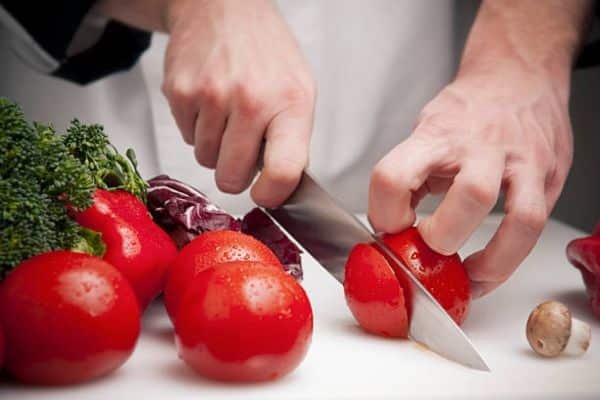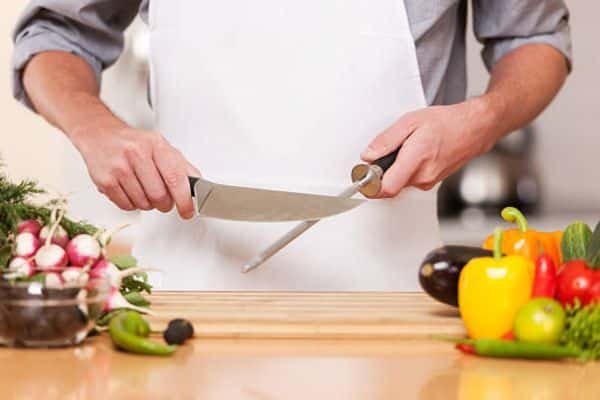The first time I tried to slice a ripe tomato, I thought my knife was sharp. I pressed down, and the blade slipped off. The tomato squashed flat, and I knew I had a problem. That moment taught me the value of knowing how to test sharpness of a knife. A sharp knife makes cooking easy and safe. A dull blade can tear food and risk harm. With a few simple checks, it’s easy to tell if your knife is ready. Let’s look at smart ways to test so you can enjoy smooth, clean cuts every time.
Why It’s Important to Know If Your Knife Is Sharp
A dull knife is more dangerous than many people think. It can slide off food and cut your hand. This is why it helps to learn how to test the sharpness. A simple check keeps your hands safe and your mind at ease.
A sharp blade makes kitchen work smooth. It cuts clean and fast. Food looks better and cooks more evenly. A good edge makes prep work a joy, not a chore.
Even the best kitchen knife set under 100 needs care. These blades lose their edge with time. A quick check helps you spot dullness before it causes trouble.
Simple Ways: How to Test the Sharpness of a Knife at Home
There are easy ways to check if it is sharp. You can do these at home in seconds. Let’s go through my go-to tests.
The Paper Test

Hold a sheet of paper by the top edge. Use to slice down. A sharp blade cuts clean through with no tear. This is one of the fastest ways to check. It works well for chef’s knives, santoku blades, and most all-purpose kitchen knives.
The Tomato or Onion Skin Test

Set a tomato or onion on your board. Place the blade on the skin. Draw the knife down without force. A sharp glides through with ease. A dull one slips or squashes the skin.
The Arm Hair Test
This one takes care. Run the blade gently over your arm. A sharp will shave hair with no push. Try this only if you feel sure and steady.
The Fingernail Test
Set the blade lightly on your fingernail. A sharp edge will catch or bite in place. A dull one slides off. Keep a soft touch to stay safe.
Pro Tips for Getting It Just Right (From My Own Kitchen)

Before you start, wipe clean and dry. A clean blade gives you a true check. Any food bits or moisture can throw you off.
Try more than one spot along the blade. The heel, middle, and tip can wear down at different rates. This helps you spot weak spots before they cause trouble.
It’s smart to combine check. Don’t go by feel alone. A knife may seem sharp but still struggle on a tomato. A quick paper slice or nail check tells the full story.
Know the difference between honing and sharpening. A hone keeps the edge straight. A sharpener takes off metal to make a new edge. I hone often and sharpen as needed.
Types of Knives and How to Tell If They Are Sharp
Each knife in your kitchen has its job. Each one also needs its check for sharpness. Here’s what works best for the common types.
A chef’s is great for the paper or tomato check. It should glide through both with no tear or slip. This blade does most of your chopping, so keep it sharp.
A pairing is smaller, but just as key. A paper strip or tomato skin works well to check it. Look for smooth, easy cuts.
A bread needs a clean crust cut. A dull blade tears the bread or crushes it. A sharp one slices through the crust and crumb without force.
When and How Often to Test Knife Sharpness

It helps to check every few uses. I like to check before a big cooking day. A quick slice through paper or a soft tomato tells me all I need to know. This small habit keeps my prep safe and smooth.
Keep a honing steel close by. A few light strokes help the blade stay true. This means you won’t need to sharpen as often. It takes just seconds and makes a big difference.
Final Thoughts
Make knife testing part of your routine. It takes seconds, but can change your time in the kitchen. A quick check keeps your blades sharp and your hands safe.
A sharp knife turns prep into a joy. It helps your food look better and cook right. Best of all, it makes every slice smooth and easy.
FAQ
How to tell if a knife is sharp or dull?
A sharp knife cuts paper or tomato skin clean. A dull blade slips or tears food. A quick slice test helps you see the difference right away.
What is the best way to test knife sharpness safely?
The paper test is a safe way to test. Hold the paper steady and slice down. The knife should glide through with no force or tear.
Do I need to test knives in a best kitchen knife set under 100 often?
Yes, you should test knives in a best kitchen knife set under 100 often. Budget blades can dull fast. Check sharpness before big cooking days to stay safe.

